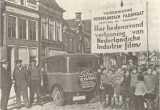Vereeniging Nederlandsch Fabrikaat: Tailor-made Company Films
When the Vereeniging Nederlandsch Fabrikaat (VNF) started up its own film division to make company films in 1925, there were no signs to indicate that they would become successful. Earlier attempts at similar enterprises in the Netherlands failed: the most infamous of these was in 1920, when a company called the Commercieele en Industrieele Film was started up by Willy Mullens and a former minister M. Treub.
The Dutch business world was just itching to have access to the most important propaganda medium of the time and was prepared to invest substantially in it. However, despite such a positive attitude toward company films, the Netherlands just wasn’t a fertile ground for a thriving company film industry. It wasn’t a matter of financing the film, or producing it; the bottleneck was in getting the film screened. The average audience just wasn’t interested in films about stearin candles or cigars.
Flourishing on limited means
The relatively small and underfunded club of volunteers that made up the VNF managed to grow into a flourishing film division, using their own film collection as a basis. This collection was made up of a number of old company films by Willy Mullens supplemented with newly produced films. These new films were all produced by Otto van Neijenhoff’s company, IWA. Much to the displeasure of the Nederlandse Bioscoopbond (NBB), he had obtained the exclusive rights to the VNF commissioned films.
The collection expanded steadily and by 1927, the archive already had 70 films. These were shown during special screenings organised by the VNF throughout the entire country. By 1930, there were already a respectable 241 films in the archive.
Secret to success
The secret to the success of the VNF’s screenings was in the infrastructure it had built up over time. The VNF had good connections with chambers of commerce and conference halls throughout the country because it had often organised events such as lectures (with slideshows) and exhibitions. In addition to this, the VNF had its own monthly magazine it used to reach its members – a guaranteed audience.
Interest fades
Around 1932, interest in the VNF’s screenings started to fade. In order to turn this around, it organised a series of open-air programmes that would tour throughout the country. Advertising man and filmmaker M. Beets was hired especially for this tour, which started in Sneek on 18 April 1932 and ended on 11 October in Boskoop. The tour was a resounding success. At the request of many shopkeepers, the VNF added on a winter tour. In the end, the VNF had organised 244 film evenings for a total of 89,000 viewers.
Delaying the inevitable
Ultimately, however, it only turned out to be delaying the inevitable. Despite the tour’s success, the interest in the regular film evenings continued to decline. Conflicts with the NBB and an incident involving the subsidy for a government campaign marked the beginning of the end of the VNF. A stubborn conservatism and the board of directors did the rest. The VNF clung for too long to the flammable 35mm nitrate film while the safer, less flammable 16mm film gradually took over the film world.
New avant-garde ideas about company films and advertisements arose, and insights from mass psychology were adopted by modern advertising agents. These developments, understood too late and never completely enough by the VNF, meant the end of the short but productive existence of the VNF’s film department.
more information
If you are looking for more material from our collection, please contact Film Sales:
sales@eyefilm.nl
phone +31 (0)20 5891 426
